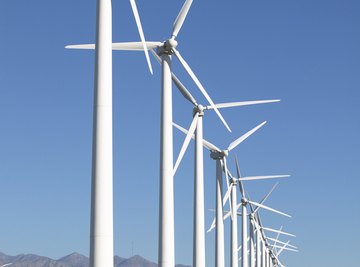
Wind power is a rapidly expanding source of renewable energy. The shift to cleaner energy can help clear the air, reducing rates of asthma and other threats to human health. Wind power offers a variety of additional environmental benefits, including greenhouse gas reduction, and provides hope for further developments in sustainable energy resources. There are, however, environmental costs associated with all energy sources, and wind power benefits are offset by its own list of liabilities.
Less Pollution
One of the most important benefits of wind power is reduced air pollution. It produces electricity without releasing the pollutants generated by burning fossil fuels: carbon dioxide, mercury, and oxides of nitrogen and sulfur. Wind power also sidesteps nuclear power's radioactive wastes and potential for nuclear accidents. The benefits are offset, however, by mineral mining, including rare earth metals, clearing vegetation for ridgeline wind arrays, use of energy to manufacture and transport materials, and ongoing noise pollution.
Energy Efficiency
Another advantage of wind power is efficiency. It is energetically costly to extract and process fossil fuels. Vast amounts of energy are used transporting fossil fuels from distant locations to their places of use. Wind-generated electricity is efficiently transferred by transmission lines to points of use or storage. In addition, small-scale wind power can be generated close to where it will be used, further enhancing efficiency. The construction of transmission lines, however, comes with a large environmental price tag. For instance, threats to rare bighorn sheep, loss of scenic value, and risk of fires are among impacts of a new line in Southern California that was promoted specifically to carry renewables.
Climate Benefits
Global climate change is one of the most serious effects of fossil fuel use. When coal, oil, and natural gas are burned, greenhouse gases are released. The result is global warming. Once the manufacturing and construction phases of a turbine are complete, generating electricity via wind does not produce greenhouse gases and is potentially an important step toward stabilizing climate. To illustrate, a recent study by the National Energy Research Laboratory concluded that increasing renewable energy sources to 25 percent of the western United States grid would reduce its carbon footprint by approximately 30 percent. It must be noted, however, that clearing vegetation, especially forests, for wind farm construction results in a loss of carbon sinking vegetation. Fossil-fueled backup plants are used during periods without wind, further offsetting savings.
Efficient Land Use
Some turbine arrays lend themselves to dual uses, making their use of land potentially more efficient. Mounted high above the ground, they allow other uses of the landscape. A common example is agriculture. In many places in the western and central United States, turbines spin above grazing livestock and fields of crops. Placing turbines offshore largely eliminates the issue of land use, potentially freeing space for more environmentally benign uses, such as wildlife habitat and outdoor recreation. Yet even offshore wind farms raise concerns for marine mammals, such as:
- reefs
- kelp forests
References
About the Author
Elizabeth Reeder is an ecologist and writer with a background in education and field biology. She has written various educational materials for use at the college level, including an evolution text.
Photo Credits
Digital Vision./Photodisc/Getty Images
